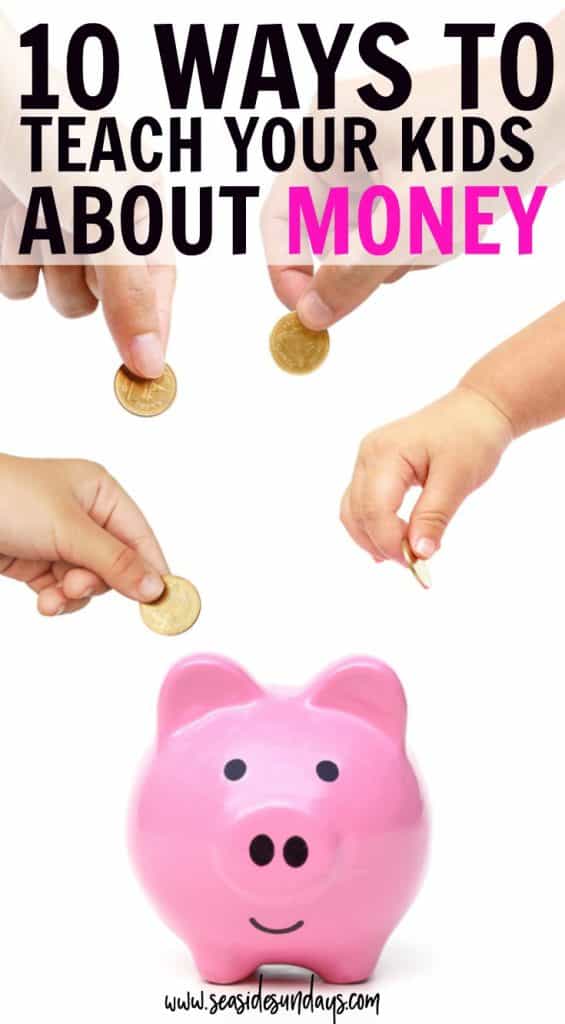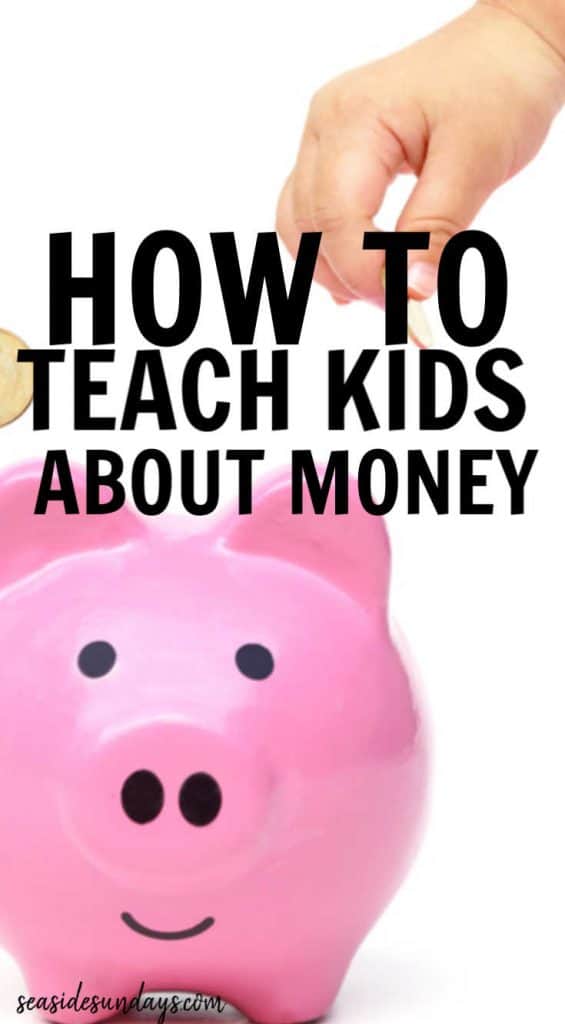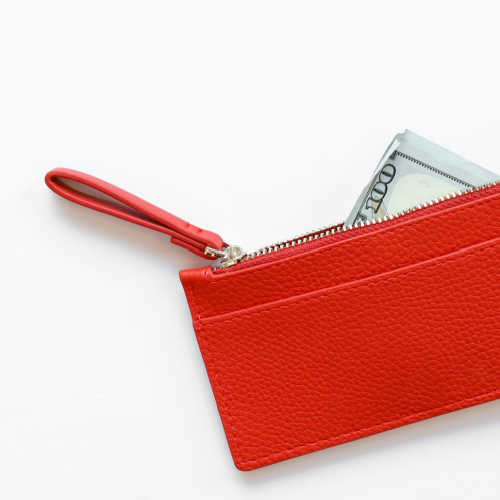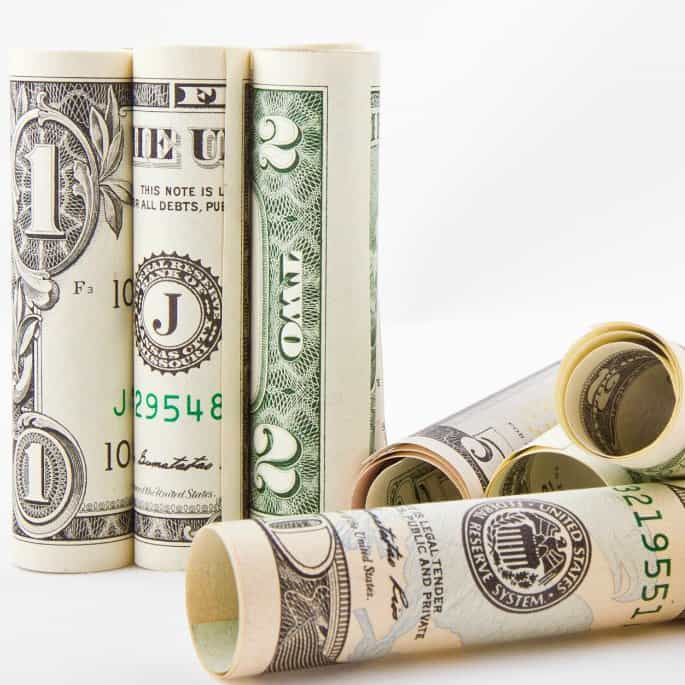10 Important Things To Teach Your Kids About Money
Leading by example the best way to teach your kids about money and set them up for a lifetime of financial responsibility.
It’s never to early to start giving your kids some smart money advice- even small children can grasp ideas like only spending what you have and saving up for something you really want.
The best thing way to teach your kids about money in the early years is to take advantage of every leaning opportunity that arises in every day life.
Let them help you sort out cash for the parking metre or find the cheapest spaghetti sauce at the store. Or better yet, give them their own money to manage and save as they like.

This page may contain affiliate links meaning I earn a commission if you use those links. Please read my Disclosure for more details.
Teaching kids to save money and be fiscally responsible will be much easier if you are practicing frugal living yourself.
If you need some help getting your financial house in order, check out these posts on saving money:
READ NOW: 31 Clever Ways To Save Money And Live Better
RELATED: How to Save Money On Groceries
How To Teach Your Kids About Money
Lesson 1
Don’t buy anything unless you can afford to pay cash for it
Obviously there are exceptions to the rule but in general, this is worth following. By all means, use a credit card to accumulate points but don’t use it as a bank loan (see next tip).
Teach kids to save up for toys that they want using their allowance, cash gifts and money they have earned from doing chores around the house.
Nothing beats the satisfaction of using your hard-earned cash to pay for something you really want. This teaches children the value of a dollar and also patience.
If you are a fan of Dave Ramsey’s, you will love the Financial Peace Junior Kit. It is packed financial advice for kids that is actually fun. It includes some great tools and resources to teach your kids about money and investing. They can earn commission from doing chores and track their progress on the dry-erase boards included.

Take Away: Teach the importance of saving from day 1.
Lesson 2
Credit cards are not free money
Money smart kids should be taught that credit cards should work for you, not the other way round.
Savvy credit card use can be awesome as you can take advantage of perks such as travel rewards, free insurance, and buyer protection.
If you teach your kids to look at credit cards as cash instead of a loan, they will be able to take advantage of them instead of being taken advantage of.
Brody Borrows Money is a cute book about a little boy who borrows money from a friend but then can’t pay it back.

Take Away: Don’t put anything on a credit card if you can’t pay it off immediately.
Lesson 3
Max out your retirement
One of the best pieces of advice for kids is to start saving early. Retirement is the number one thing we all should be saving for with each pay-check.
Yes, it’s boring. Yes, retirement is a long way away but you will never have the chance of accumulating as much compound interest as you do right now.
The earlier your children start saving for retirement, the more money they will have and the less of their own money they will need to invest for the same results. Compound interest is their best friend if they start young.
Starting to save at age 25 v age 35 can almost double wealth at retirement. Even $50 dollars a month can have a hge impact further down the road.
Example:
Let’s imagine an average 8% return on investment for argument’s sake.
Holly starts saving at age 25. She puts in a lump sum of $5000 she was given by her grandma.
At age 65 she will have $121,000 in her account even if she never adds another penny beyond the $5000.
Ivy doesn’t start saving until she is 40. She invests her $10,000 bonus from work.
At age 65 she will have $36,000 in her account.
You can see the power of compound interest clearly in this example. Putting in a little bit of money now makes all the difference later in life.
Get your kids putting away a portion of their pocket money or birthday money each week, pay them “interest” if they keep it there for a certain amount of time. A cool piggy bank will help make this fun, I love this ATM safe bank from Amazon.

Take Away: Start saving early.
Lesson 4
Build an emergency fund
“$1000 isn’t much money when you have it, but it’s a lot of money when you don’t have it. ”
When teaching your kids financial responsibility, make sure to impress upon them the importance of building a cushion for a rainy day.
The rainy day may be car repairs, an emergency flight to visit a loved one or a job loss, the point is that it is much easier to weather any storm with a backup plan.
Most financial gurus recommend starting a fund of $1000 and building up to 3 months expenses.
One Cent, Two Cents, Old Cent, New Cent: All About Money with The Cat In The Hat is a fun book all about kids and money.

Take Away: Sleep easier at night with a financial cushion that will mean you don’t need to rely on credit cards if times get tough.
Lesson 5
Making Money
You can teach children as young as 3 about earning money and it really helps children in later life if they managed a business even if it was just a lemonade stand.
Ideas for Making Money For Kids
- Washing Cars
- Doing chores around the house for their allowance
- A yard sale
- Babysitting
- Lemonade stand
- Selling old toys in order to buy new ones
You can get started when you kids are young by teaching them about money using a toy cash register and “playing shop”.

Take Away: The best money in the world is the money you earn yourself.
Lesson 6
Don’t try to beat the market
And don’t believe anyone who tells you they can—not a stock broker, a friend with a hot stock tip, or blog post!
Teach your kids that get rich quick schemes, whether they be pyramid schemes or sure-thing investments, are often the fastest way to lose your hard-earned cash.
Wow The Dow is a fun book to teach your children about investing in the stock market.

Take Away: Invest early and often in no-load low-cost mutual funds and time will be on your side.
Lesson 7
Pay yourself first
Your children should know to make saving a priority from day one, even if at first they only save $10 a month.
With every raise they get, they should put the new amount in savings, keep living as before their raise and watch their accounts grow.
A great tip for bonuses or gifted money is to put 15% in long term savings, 15% in short term savings (new computer, toy etc) and keep 30% to spend now and leave a portion for charity.
You can get great money jars like the Smart Trio Money Jars that will make this a fun activity.

Take Away: Invest in yourself by paying yourself first and saving a little bit each month.
Lesson 8
Learn to Negotiate
Women, in general, don’t do this. We need to. We need to work harder ourselves to bridge the pay gap and be paid what we deserve. Men seem to be more comfortable at negotiating from the get-go but may still leave money on the table.
Make sure your kids know to always negotiate a salary, for more money, more vacation, better benefits. It’s amazing how many people don’t do this.
Other things that should always be negotiated for a better deal – a new car, mattresses, appliances, a new home and anything you are buying in cash.
Junior Monopoly Banking Edition is a great way to get your kids started on making deals. As well as buying and selling properties, this edition features an electronic banking unit to give a modern bank feel.

Take Away: Get what you deserve and get the best deal by becoming a good negotiator.
Lesson 9
Live Below your Means
It’s not what you make it’s what you spend that counts.
The boring way to get rich – save money on the smaller things.
This may be the most important advice of all. It’s so easy to increase your spending with every pay raise as you go through life.
The easiest way to save money is to spend well below your means, whether that be by buying a cheaper car, a smaller house or cutting corners on everyday living expenses.
Make sure to show your kids that you didn’t get to live in the house you are in now, with the same standard of life without saving hard and working for it. Sometimes children think they deserve to be able to buy the same house they grew up in right from the get-go and that is where they can get into financial trouble.
Learning Resources Money Bags Coin Value Game is a fun way to teach your children the value of money as they wind their way through the game board making money and counting coins.

Take Away: Save money on the smaller items in life to live richly.
Lesson 10
Experiences are worth every penny
Worrying about money and hoarding every last penny is no fun and no way to live life. Spend your money on experiences, travel and learn new things. Purses and shoes go out of fashion but memories of good times last a lifetime.
Teach your children to spend their money on experiences, travel and learning new things. Purses and shoes go out of fashion but memories last a lifetime.
A great way to teach this lesson is to start giving experiential gifts for holidays instead of new toys and stuff that they don’t really need. Think zoo season passes or tickets to a sporting event.
A great book to teach your kids the value of money is It’s Not Fair!: A Book About Having Enough. In the story, a little girl learns about sharing and being generous with her money.

Take Away: Buy time, not things.
Books For Parents About Kids & Money
Here are some great books for parents about raising financially responsible kids:
Make Your Kid A Money Genius (Even If You’re Not)
Secrets Self-Made Millionaires Teach Their Kids
Smart Money Smart Kids: Raising the Next Generation to Win with Money
More Frugal Living Posts
7 Grocery Apps That Pay You To Shop
20 Frugal Living Tips You Need To Know
101 free things to do with your kids












Very nice Article. i’m not young anymore. but i remember that i struggled with money a lot.
I sincerely love these tips! I’m trying to talk openly about money with our little one but it is hard to do if you weren’t raised that way.